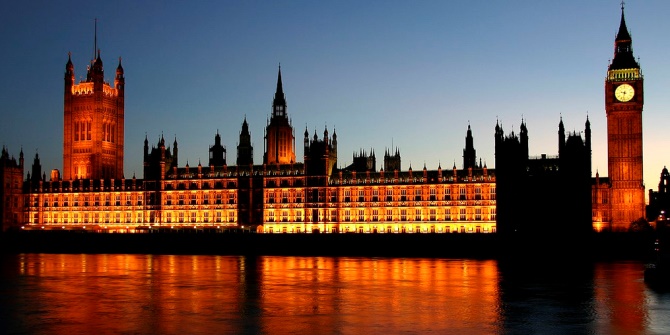 In the second of his posts looking at some key questions around the AV debate, Alan Renwick from the University of Reading moves on to examine how the AV system would affect the national picture. Using simulations of the previous seven elections, he provides evidence on how AV would affect the major and minor parties, the frequency of hung parliaments and the representation of women and minorities.
In the second of his posts looking at some key questions around the AV debate, Alan Renwick from the University of Reading moves on to examine how the AV system would affect the national picture. Using simulations of the previous seven elections, he provides evidence on how AV would affect the major and minor parties, the frequency of hung parliaments and the representation of women and minorities.
As noted in my previous post, it is difficult to predict how past election results would have changed under different electoral systems. However, surveys that ask respondents to indicate second and sometimes lower preferences can be used to simulate what the result of an election would have been had AV been used. Such simulations have limitations, as discussed below. But they do give a useful rough guide.
The table below compares actual election results since 1983 with the simulated results under AV produced by John Curtice (for the 1983–2005 elections) and the British Election Study (for 2010).
Simulated AV election results compared to actual results, 1983–2010
| 1983 | 1987 | 1992 | |||||||||
| Actual seats won | Seats under AV | Change | Actual seats won | Seats under AV | Change | Actual seats won | Seats under AV | Change | |||
| Con | 397 | 391 | -6 | 375 | 381 | +6 | 336 | 328 | -8 | ||
| Lab | 209 | 190 | -19 | 229 | 202 | -27 | 271 | 268 | -3 | ||
| Lib Dem | 23 | 48 | +25 | 22 | 44 | +22 | 20 | 31 | +11 | ||
| Others | 21 | 21 | 0 | 24 | 24 | 0 | 24 | 24 | 0 | ||
| Majority | 144 | 132 | -12 | 100 | 112 | +12 | 21 | 5 | -16 | ||
| 1997 | 2001 | 2005 | |||||||||
| Actual seats won | Seats under AV | Change | Actual seats won | Seats under AV | Change | Actual seats won | Seats under AV | Change | |||
| Con | 165 | 70 | -95 | 166 | 140 | -26 | 198 | 171 | -27 | ||
| Lab | 418 | 445 | +27 | 412 | 423 | +11 | 355 | 377 | +22 | ||
| Lib Dem | 46 | 115 | +69 | 52 | 68 | +16 | 62 | 68 | +6 | ||
| Others | 30 | 30 | 0 | 29 | 29 | 0 | 31 | 31 | 0 | ||
| Majority | 177 | 231 | +54 | 165 | 187 | +22 | 64 | 108 | +44 | ||
| 2010 | |||
| Actual seats won | Seats under AV | Change | |
| Con | 306 | 284 | -22 |
| Lab | 258 | 248 | -10 |
| Lib Dem | 57 | 89 | +32 |
| Others | 29 | 29 | 0 |
| Majority | – | – | – |
These simulations of past elections imply a number of points. AV always boosts the Liberal Democrats: as a centrist party, they pick up many second preferences. It sometimes also boosts a landslide winner (a party winning many first preferences is likely to gain lower preferences too). Overall, however, AV does not increase national proportionality compared to FPTP. It does not generally help small parties win seats. It can exaggerate the over-representation of the largest party. Like FPTP, it can produce biased election results, where two parties with the same vote shares secure very different numbers of seats.
It is thus possible, under AV as under FPTP, for one party to win most votes while another wins most seats. This happened under FPTP in the UK in 1951 and February 1974. It has happened under AV in the Australian federal elections of 1954, 1961, and 1969, as well as in a number of state elections.
Contrary to some claims, AV would not lead to permanent hung parliaments and coalition governments. Of the last seven elections, only the most recent would have delivered a hung parliament – just as under FPTP. By boosting the Liberal Democrats, however, AV does increase the likelihood of hung parliaments a little. Some simulations suggest a hung parliament in the close election of 1992.
AV tends to exaggerate landslides. This is because of the boost it can give to a party with a large national lead. The clearest case of this is the large projected increase in Labour’s majority in 1997. But AV would not, according to these simulations, have boosted the Conservatives’ majority in 1983.
But would AV induce more fundamental change in the party system?
Simulations such as those above need to assume that the party system will remain basically the same. But it is possible that, under AV, voters would think about the parties differently and that the overall menu of parties would change. There is a logic, long recognized among political scientists, according to which an electoral system such as AV should be expected to produce two-bloc politics, or “bipolar multipartism”: a system with many parties in which those parties line up into two fairly stable blocs. Multiple parties on the right or on the left would be able to compete among themselves without letting their opponents in on a minority vote, so they would face little pressure to coalesce.
We can see something of this in Australia, where the Liberal and National parties form a stable coalition on the right. But the Australian party system has not fragmented under AV as some predicted: using a standard measure of fragmentation, the Figure below shows that Australia and the UK are actually very similar in this respect. It appears that there are still strong pressures for parties to remain unified under AV, as under FPTP.
Party system fragmentation in Australia and the UK
Still, there is a question over the future of the Liberal Democrats in the UK. The simulations assume they will stick together and benefit from AV. But AV would put pressure on the Liberal Democrats as a party to state to whom they would like their supporters to give their second preferences: Australian experience suggests that parties generally gain from issuing such guidance. In current circumstances, that might increase the likelihood of a split in the party between left and right. On the other hand, the Australian Democrats achieved success for some years without issuing guidance, hoping thereby to attract support from both left as well as right. The Liberal Democrats in the UK might be able to maintain the same strategy.
How would AV affect small and fringe parties?
So how would AV affect smaller parties, such as the BNP, UKIP and the Greens, in the UK? Evidence and logic point to three effects. First, AV makes it easier for such parties to win votes: a vote cast for a small party need no longer be “wasted”, as the voter can support one of the main parties with their second preference.
Second, AV makes it harder for fringe parties to win seats, as parties adopting positions far from the centre ground are unlikely to pick up many second preferences. The fate of Australia’s Pauline Hanson is instructive here: she would have won a seat in the 1998 election under FPTP, but AV thwarted her, as she picked up very few lower preferences from mainstream voters.
Third, AV gives small parties bargaining power over large parties. In many seats, the leading candidates will need the second preferences of small-party supporters if they are to secure victory. The small parties are likely to seek policy concessions before agreeing to ask their supporters to transfer their votes to a particular party or candidate. In Australia, this mechanism has given such parties as the Democratic Labor Party, the Australian Democrats, and the Green Party significant influence, even when they have failed to win any seats.
On the other hand, Australia’s experience also suggests that such bargaining is of little benefit to extreme parties, because the mainstream parties refuse to deal with them. This helps explain the earlier mentioned failure of Pauline Hanson’s One Nation party in 1998. When some politicians gave in to the temptation in the Queensland state election of 2001, they appear to have been punished by voters for doing so. Overall, Professor Ben Reilly concludes that AV in Australia “has pushed the political system away from extremes and towards the ‘moderate middle’”.
What are the effects of hung parliaments and coalition or minority governments?
Given the simulations discussed above, AV would probably slightly increase the likelihood of hung parliaments. This would not be a radical change: fragmentation of the vote means that hung parliaments have become increasingly likely under FPTP too in recent years. Nevertheless, it is important to consider what the effects of more hung parliaments would be.
In fact, hung parliaments can be praised or criticized on many grounds: there is no consensus. There is strong evidence for some key points:
- coalition or minority governments are less stable than single-party majority governments;
- government spending tends to be higher with coalition than with single-party governments; budget deficits tend also to be higher with coalitions;
- there are rich countries that routinely have coalition governments as well as rich countries that generally have single-party-majority governments: doom-mongering is not justified;
- coalition governments encourage more consensual decision-making;
- the connection between the votes cast and the composition of government is generally clearer when one party has a majority;
- hung parliaments rarely give excessive power to small parties: the oft-cited example of the German FDP is unusual.
Would AV increase the representation of women and minorities?
FPTP leads to underrepresentation of women and of minorities that are not geographically concentrated. It is still the case today that only 22 per cent of Westminster MPs are women while 4 per cent are from minorities. The crucial factor determining representation for women and dispersed minorities is the number of MPs elected in each constituency. Where only one MP is elected, selection committees and voters will seek out the candidate they think strongest. So long as there remain even subconscious biases about who makes the best MP, white men will be overrepresented. Where several people are elected per constituency, by contrast, parties and voters are likely to seek more balance.
AV retains the single-member constituencies of FPTP. It should not therefore be expected to alleviate underrepresentation of women and minorities. We can see this from the Australian House of Representatives, where the proportion of members who are women is 25 per cent – little different from the figure in the UK.
A change to AV would not fundamentally change how parliament is made up, but it may mean we start to think differently about how we vote and whom we vote for.
This article has been adapted from Alan Renwick’s paper The Alternative Vote: A Briefing Paper
Please read our comments policy before commenting.







I imagine there are many factors that determine how many women MPs there are in Parliament.
You suggest that voter bias towards white males combined with single member constituencies is a major factor. Are men and women voters equally biased?
Although this is perceived from one viewpoint as bias, it is also an expression of the democratic wish of the people. Is the desire to achieve a specific socio/political change a justifiable consideration when looking at the pros and cons of different electoral systems?
An electoral system should be assessed for its ability to reflect accurately the democratic will of the people, not on whether it can force a desired result, however desirable.
To what extent do we still vote for the candidate rather than the party? With most electoral systems the voter has to balance the desire to support their preferred party against the desire to elect the best candidate. When the voter perceives that these two considerations do not coincide, I imagine the party label usually proves decisive.
How would the situation differ if a single member electoral system was used where the MP was elected purely on the basis of perceived merit, where support for the party to form the Government was expressed in some other way? Would you expect more women MPs to be elected?
In such a situation, if parties act as a block, the best candidates might be successful as independent candidates.
With electoral decisions based purely on merit, could women candidates be expected to reach their full potential?